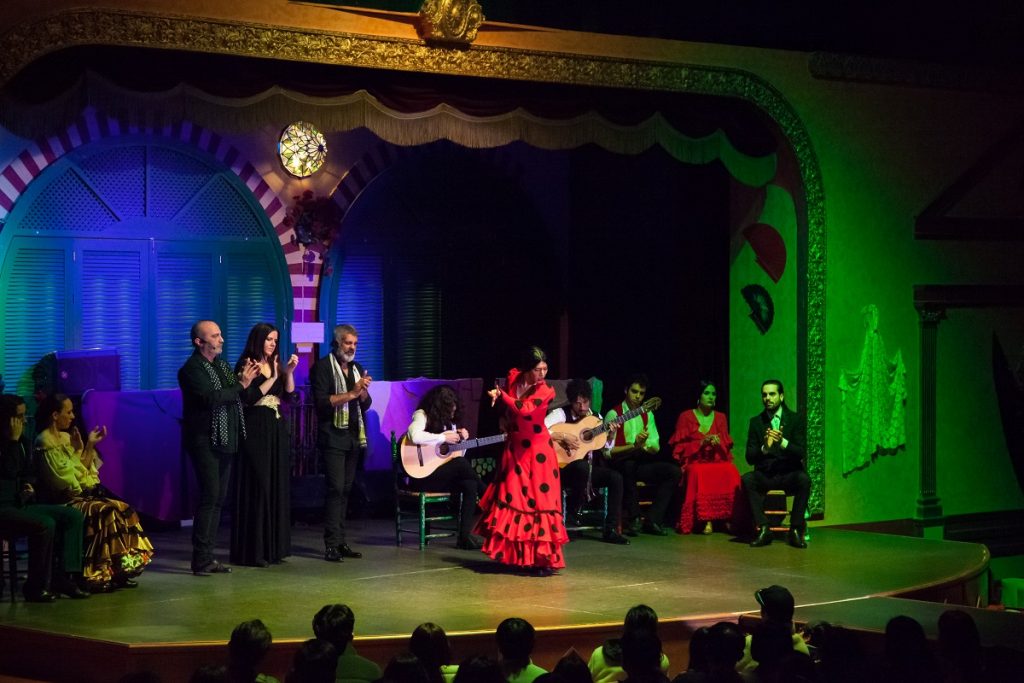- Daily shows: 7 pm, 7:40 pm, 9:30 pm and 10:10 pm

The flamenco rumba is a popular flamenco form of celebration in celebrations and fairs. A happy rhythm that when it sounds invites to move the body. This style derives from the Cuban rumba, guaguancó. She arrived in Spain, thanks to the commercial exchanges that took place with Latin America during the 19th and early 20th centuries, a time when various musical genres were imported.
These styles gave rise to flamenco styles, such as tangos and, derived from it, rumba, although with greater speed and abandoning the setback so typical of tangos. As with other styles, it is not entirely clear what the origin of the flamenco rumba might have been. What is unanimous is that the happy rhythm is reminiscent of guaguancó, guaracha and rumbitas campesinas, from Cuba.
The rumba is still a derivation of flamenco tangos, which is why the mix of all these styles gave rise to the rumba that we know today, which has become one of the most frequent dances in any celebration. It is a style that competes in joy and energy with bulerías.
Also known as chuflas, one of the most flamenco Andalusian cities next to Seville, Cádiz, had special relevance in its flamenco settlement. In fact, the first flamenco rumberos are from Cádiz, like the singer Pepa de Oro, one of the pioneers of this genre. The rumba boom was in the 60s of the 20th century, with artists such as El Jacket, Beni de Cádiz and Chano Lobato, among others.

The flamenco rumba is a style with different tones (major, minor, Doric or Andalusian modal). In fact, it is not only one of the most danced, but any song can adapt to its rhythms, that is why we find that many artists use it to make “flamenco” variations to their songs.
Some like Ricardo Gaberre, known as the «Junco»; Paco de Lucía; Los Chunguitos; Los Chichos; El Fary; Las Grecas; Azúcar Moreno, Rosario Flores or Los del Río (creators of the famous song Macarena).
As for the compass, that of the flamenco rumba is binary. However, what most characterizes it is a guitar strum that accompanies it during cante and whose origin is found in the Cuban rumba that we mentioned before.
The dance also has elements that make it unique, since it is very mobile. It is played a lot with the shoulders, hips and pelvis, emitting a certain sensuality, which is also reminiscent of Cuban dances.
Another element is the percussive sound of the palms, since they mark the times and accompany that dance so joyous that, normally, flamenco dancers do alone, with exaggerated movements, body twists and very marked movements, almost similar to seizures .
It is one of the flamenco dances that lends itself most to improvisation, since although characteristic steps of flamenco are used, the real revelry arises when you let yourself be carried away by the rhythm and the music.
 The Catalan rumba
The Catalan rumbaAnother of the best-known forms of flamenco rumba is the Catalan rumba, which was born in the gypsy community of Barcelona in the 1960s. It is said to be a derivation of flamenco, since although it has similar rhythms, it also contains some differences that makes it a musical genre of its own.
It is a fusion of Catalan and Andalusian songs, always with the base of the Cuban rumba. In his performance, he participates in singing, dancing, guitar, bongos, piano, electronic keyboards and even timpani. Artists of the stature of Antonio González “El Pescaílla” or Peret, brought her from Barcelona to the national and international scene.
In the 70s, Gato Pérez brought the genre closer to jazz and salsa, giving Catalan rumba another twist and moving it further and further away from the flamenco rumba that had been heard until then.
Be that as it may, the important thing is that when you listen to a flamenco rumba you are encouraged to dance it and let yourself be carried away by the rhythm of its music. Enjoy flamenco feeling and living it.
If you are interested in learning how to dance flamenco rumba, we invite you to learn about our online course by Marisa Risu, a professional dancer.
© 2023 El Palacio Andaluz. All rights reserved.